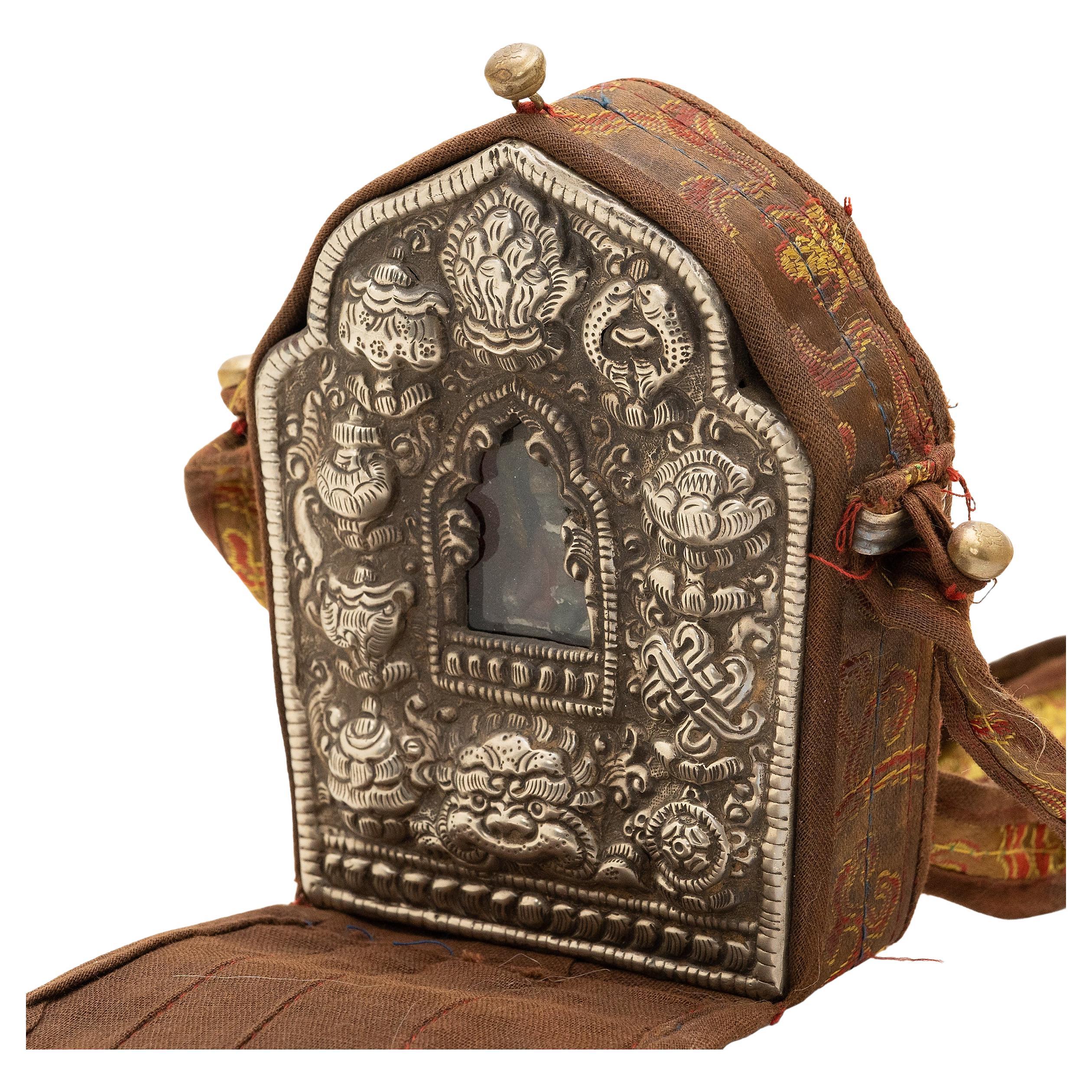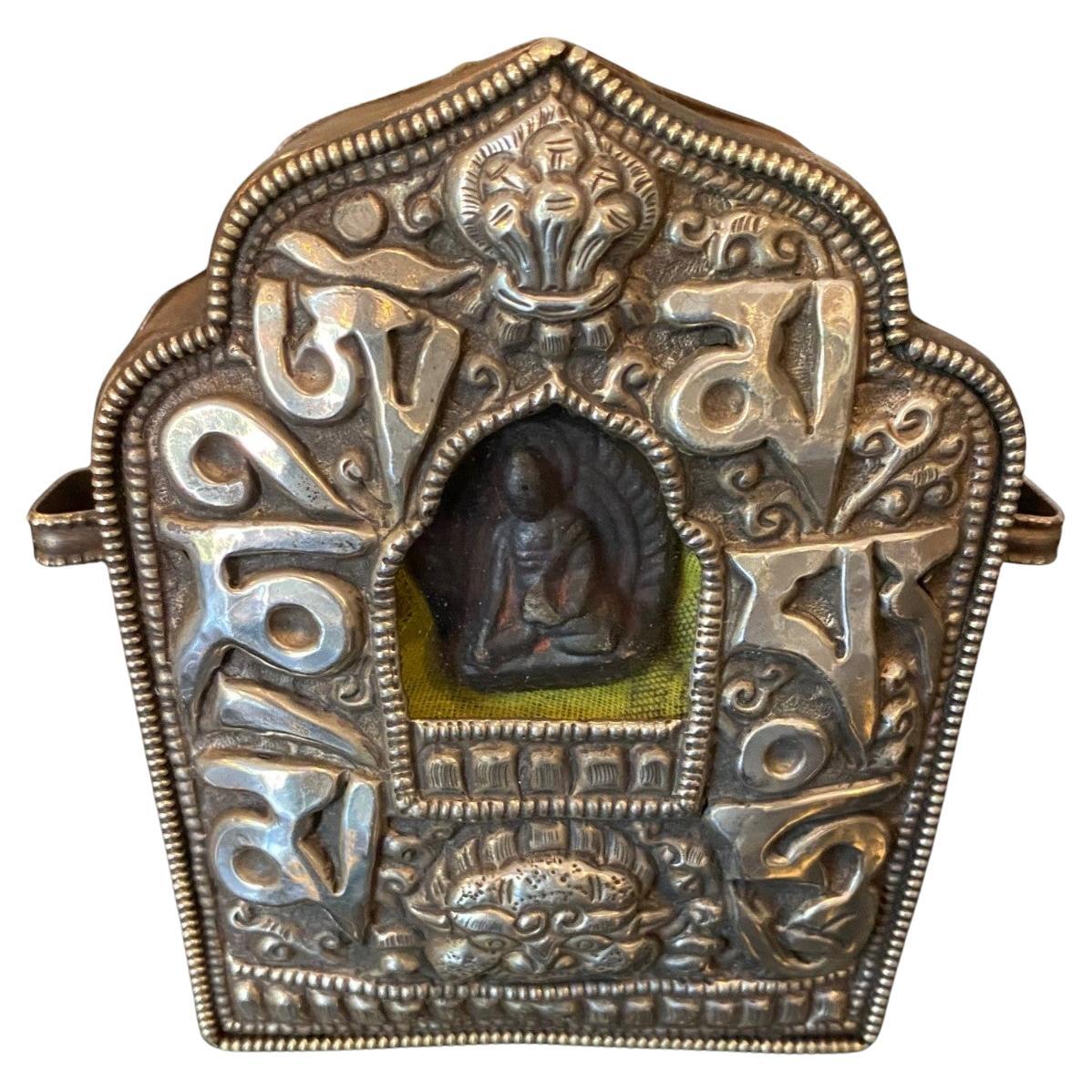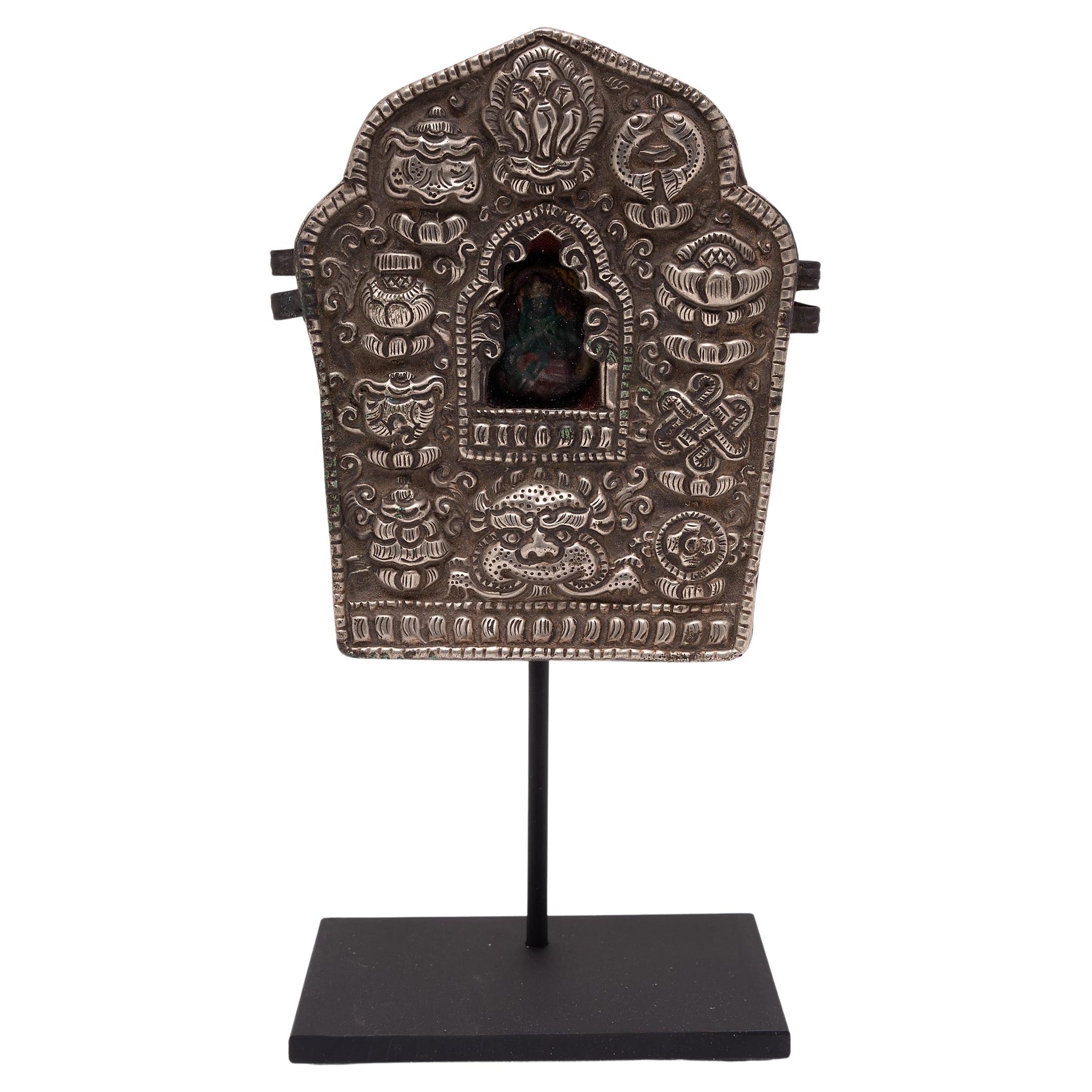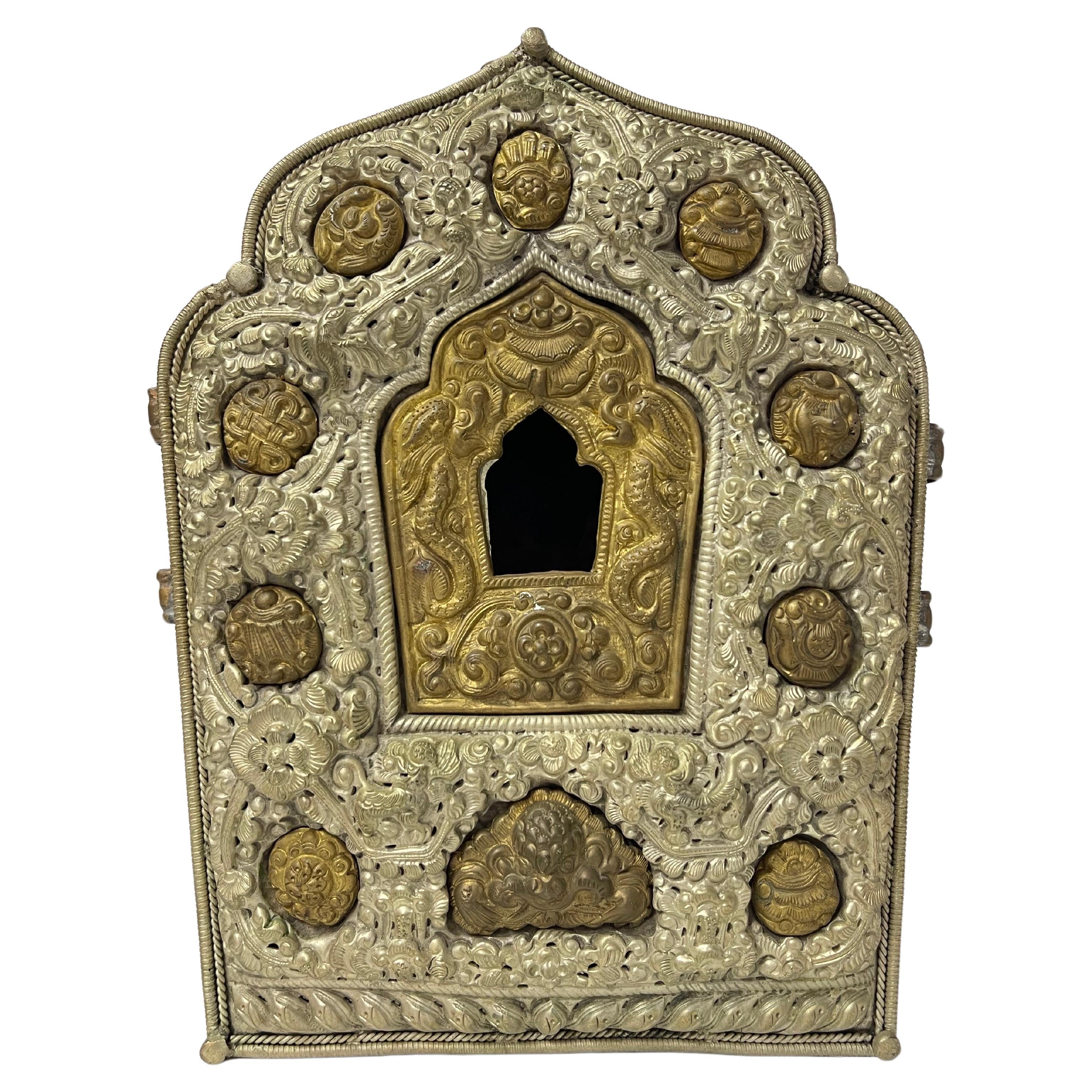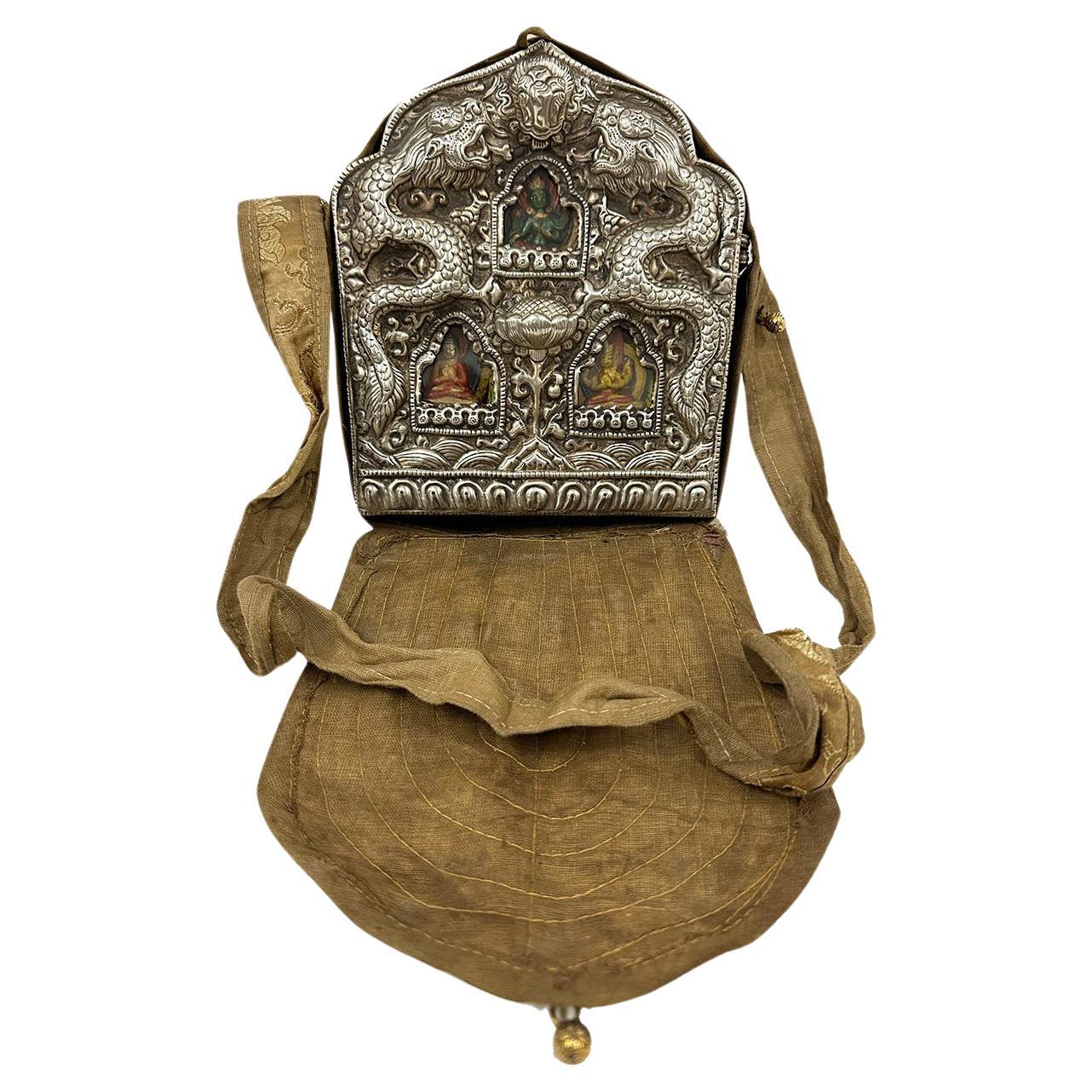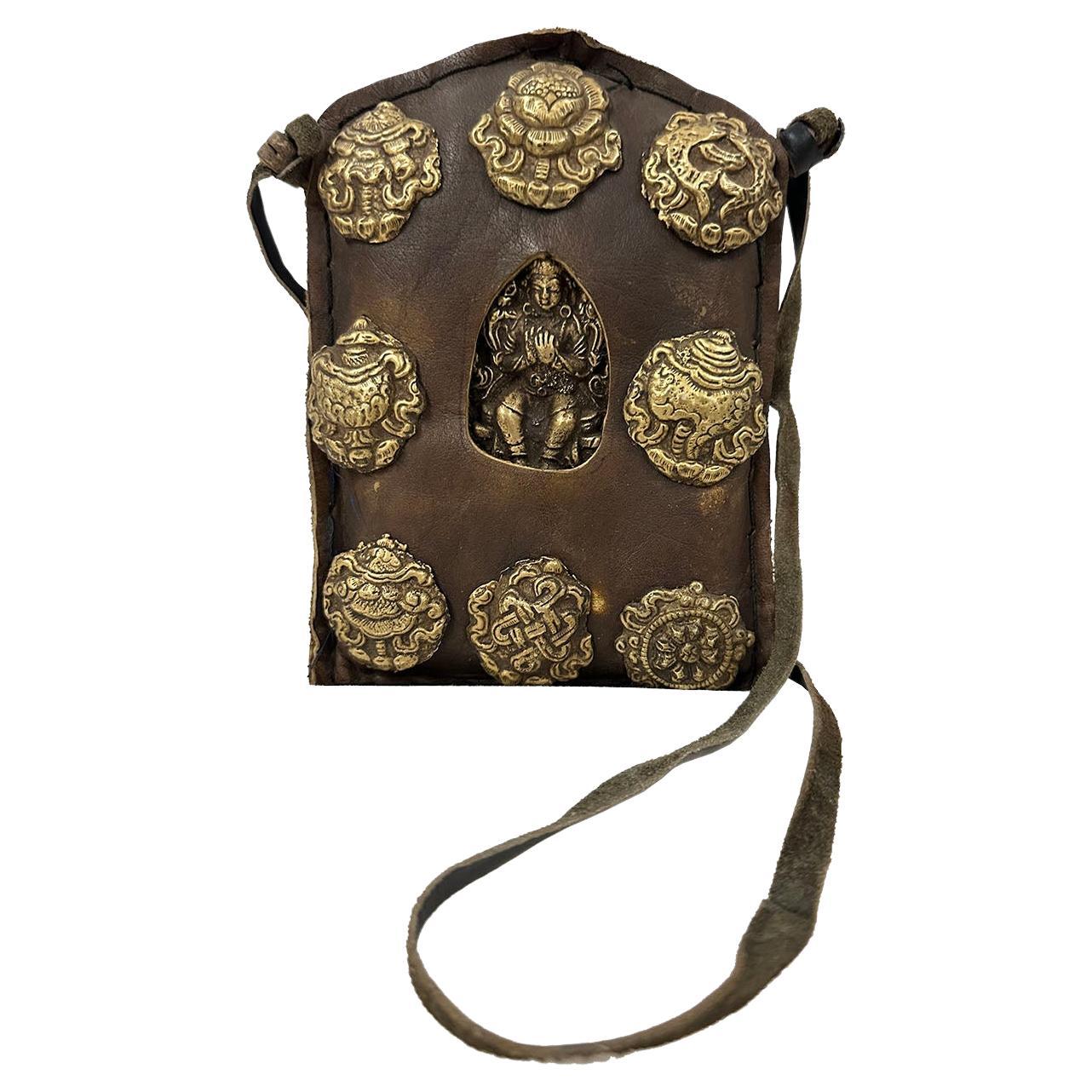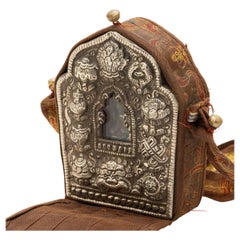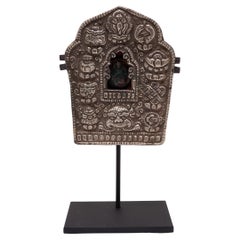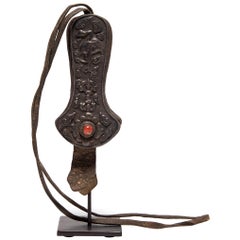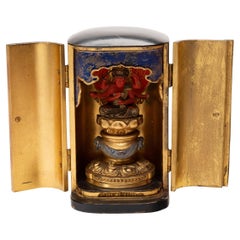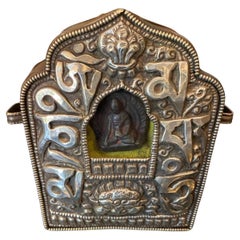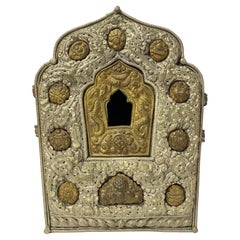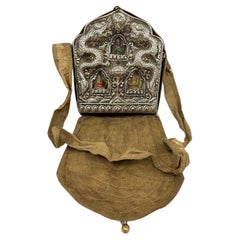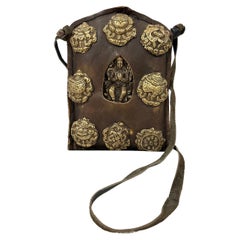Items Similar to Tibetan Gau Traveling Shrine with Silk Case, c. 1900
Want more images or videos?
Request additional images or videos from the seller
1 of 5
Tibetan Gau Traveling Shrine with Silk Case, c. 1900
$580
£438.93
€504.14
CA$824.79
A$894.24
CHF 471.26
MX$10,874.83
NOK 5,863.26
SEK 5,544.67
DKK 3,763.69
About the Item
Tibetan traveling shrines, known as Gau, were believed to offer protective powers and were used to hold and carry sacred objects during long journeys. Crafted over a century ago, a Buddhist follower may have purchased this intricate gau while on religious pilgrimage to a temple or holy site.
The large brass shrine is decorated in repoussé with decorative scrollwork and several Buddhist symbols in low relief. At the top of the shrine is the cintamani, or wish-fulfilling jewel, shown here as a cluster of flaming pearls. At the bottom is the kirtimukha, or ‘face of glory,’ a powerful demon believed to be a fearsome guardian of thresholds and sacred spaces.
The remaining eight motifs are each of the ribbon-clad Buddhist auspicious symbols, including the parasol, the banner of victory, the conch shell, the treasure vase, the lotus, the wheel of life, the endless knot, and the pair of golden fishes. These symbols of good fortune represent the offerings that were made by the gods to Shakyamuni Buddha when he attained enlightenment. These intricate symbols surround a central glass panel displaying a petite figure of a seated Buddha in meditation.
The shrine has been paired with a quilted silk carrying case by which the shrine could have been slung across one’s shoulders and carried long distances.
From the collection of Frances and Gary Comer.
- Dimensions:Height: 5.5 in (13.97 cm)Width: 4.5 in (11.43 cm)Depth: 2 in (5.08 cm)
- Style:Tibetan (In the Style Of)
- Materials and Techniques:
- Place of Origin:
- Period:
- Date of Manufacture:circa 1900
- Condition:Wear consistent with age and use.
- Seller Location:Chicago, IL
- Reference Number:Seller: CFC5831stDibs: LU820041857182
About the Seller
5.0
Platinum Seller
Premium sellers with a 4.7+ rating and 24-hour response times
Established in 1997
1stDibs seller since 2006
1,724 sales on 1stDibs
Typical response time: 3 hours
- ShippingRetrieving quote...Shipping from: Chicago, IL
- Return Policy
Authenticity Guarantee
In the unlikely event there’s an issue with an item’s authenticity, contact us within 1 year for a full refund. DetailsMoney-Back Guarantee
If your item is not as described, is damaged in transit, or does not arrive, contact us within 7 days for a full refund. Details24-Hour Cancellation
You have a 24-hour grace period in which to reconsider your purchase, with no questions asked.Vetted Professional Sellers
Our world-class sellers must adhere to strict standards for service and quality, maintaining the integrity of our listings.Price-Match Guarantee
If you find that a seller listed the same item for a lower price elsewhere, we’ll match it.Trusted Global Delivery
Our best-in-class carrier network provides specialized shipping options worldwide, including custom delivery.More From This Seller
View AllTibetan Gau Traveling Shrine with Silk Case, c. 1900
Located in Chicago, IL
Tibetan traveling shrines, known as Gau, were believed to offer protective powers and were used to hold and carry sacred objects during long journeys. Crafted over a century ago, a B...
Category
Early 20th Century Tibetan Tibetan Figurative Sculptures
Materials
Copper, Brass
Tibetan Repoussé Traveling Shrine, c. 1850
Located in Chicago, IL
Tibetan traveling shrines, known as Gau, were believed to offer protective powers and were used to hold and carry sacred objects during long journeys....
Category
Antique Mid-19th Century Tibetan Tibetan Mounted Objects
Materials
Brass
Tibetan Silver Repoussé Needle Case, c. 1850
Located in Chicago, IL
Lavishly decorated with repoussé, auspicious Buddhist symbols, and a bit of coral, this 19th century silver needle case was once filled with the nee...
Category
Antique Mid-19th Century Tibetan Tibetan Mounted Objects
Materials
Silver
Japanese Zushi Traveling Shrine of Aizen Myō-ō, c. 1850
Located in Chicago, IL
A simple exterior of black lacquer belies the splendor within this late 19th-century Japanese traveling shrine (zushi). The hinged doors open to reveal a lustrous gold interior and a...
Category
Antique Mid-19th Century Japanese Edo Figurative Sculptures
Materials
Wood
Japanese Zushi Traveling Shrine of Bishamonten, c. 1800
Located in Chicago, IL
This gorgeous Japanese red lacquer traveling shrine (zushi) protects a miniature statue of Bishamonten, the Buddhist God of Warfare here depicted as an armor-clad warrior. A fearsome protector, he is thought to defend sacred places, punish evil-doers, expel demons and bestow wealth. In this example, Bishamonten stands atop a crouching demon, dressed in finely painted armor...
Category
Antique Mid-19th Century Japanese Edo Figurative Sculptures
Materials
Wood
Tibetan Tsa Tsa on Mount, c. 1900
Located in Chicago, IL
This molded ceramic tsa tsa brick depicts Buddhist deities. The tsa tsa is a meditation created in a monastery by a Buddhist monk in training and was sold to r...
Category
Early 20th Century Tibetan Tibetan Sculptures and Carvings
Materials
Ceramic
You May Also Like
Tibetan Gau Traveling Buddhist Protection Shrine with Buddha and Silk Case, 1900
Located in Studio City, CA
A beautifully crafted Tibetan Buddhist traveling shrine, known as Gau. These objects were believed to be protective talisman and were used to carry a number of sacred objects such ...
Category
Antique Late 19th Century Tibetan Tibetan Sculptures and Carvings
Materials
Metal, Silver, Brass, Copper
Tibetan Traveling Prayer Shrine Gau
Located in Redding, CT
Tibetan Traveling Prayer Shrine Gau. A large antique Tibetan Buddha shrine or prayer box (also known as Gau) which would encases a Buddha figure...
Category
Antique Early 1900s Anglo-Indian Antiquities
Materials
Metal, Brass, Copper
$1,296 Sale Price
28% Off
Early 20th Century Large Antique Tibetan Ghau Prayer Box With Three Buddha
Located in Pomona, CA
Ghau is a prayer box worn as pendant by Buddhists as portable shrines which can be pray by prayer during their travel. This large Ghau prayer box (travel Buddha...
Category
Early 20th Century Chinese Chinese Export Decorative Boxes
Materials
Silver, Bronze
20th Century Tibetan Leather, Brass Ghau Prayer Bag
Located in Pomona, CA
Ghau is a small prayer box/bag worn as pendant by Buddhists as portable shrines which can be pray by prayer during their travel. This Ghau prayer bag (travel Buddha...
Category
Mid-20th Century Chinese Chinese Export Antiquities
Materials
Brass
Tibetan Travelling Buddha Shrine
Located in Houston, TX
A large antique Tibetan Buddha shrine or prayer box (also known as Gau) which encases a painted terracotta Buddha figure, all wrapped in a hand embroidered quilted silk brocade. This was used as traveling shrine and carried on one's person when away from home.
Beginning with the “om” written on the left hand side of this traveling shrine, an itinerant Tibetan monk once traced his fingers clockwise over the embossed characters. As he did this, he recited "om ma ni padh mey hum," the universal Tibetan Buddhist prayer for the well-being of all sentient beings. Known as a Gau, this portable shrine...
Category
Antique Early 1900s Tibetan Antiquities
Materials
Copper, Silver
Early 20th Century Antique Tibetan Silver Turquoise Ghau Prayer Box
Located in Pomona, CA
Ghau is a small prayer box worn as pendant by Buddhists as portable shrines which can be pray by prayer during their travel. This Ghau prayer box (travel Buddha...
Category
Early 20th Century Chinese Chinese Export Decorative Boxes
Materials
Silver
More Ways To Browse
Tibetan Antique
Antique Tibetan Furniture
Antique Parasol
Lotus Vase
Endless Knot
Wheel Of Life
Meditation Seat
Traveling Shrine
Tibetan Shrine
Threshold Guardian
Tuscan Sculpture
Used Furniture Marin
Vintage Car Mascots
Vintage Hummel
Vintage Murano Glass Clowns
Wheat Sculpture
Antique Artist Mannequin
Art Deco Flapper Girls
